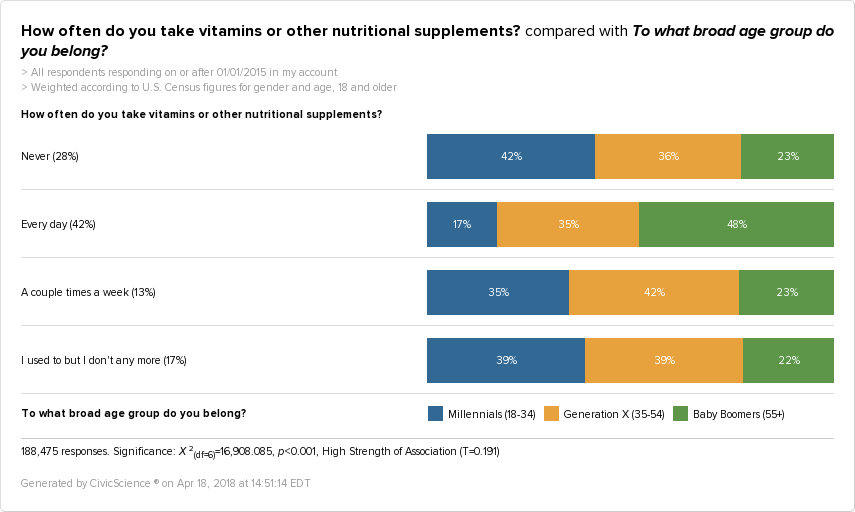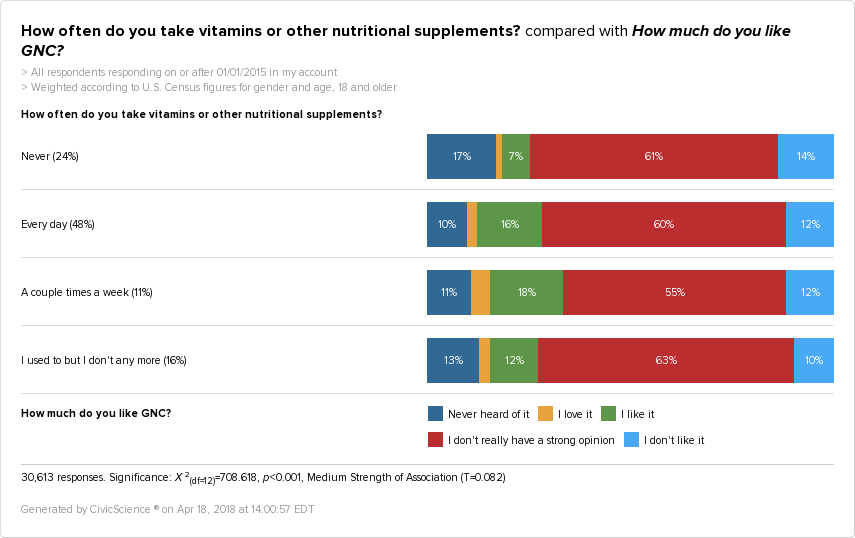The Gist: US adults either take vitamins every day or not at all. Baby Boomers dominate the vitamin consumption world, as do those who make less than $50k a year. But for heavy social media users, vitamins are a thing of the past.
These days, vitamins and health supplements are all the rage. From personalized subscription vitamin packs to ancient nutritional supplements (think: turmeric) bursting back onto the scene, the world of vitamins and supplements is having a moment.
Or, is it?
With all of the hype around healthy lifestyles, superfoods, and radical diet changes, we thought we’d take a look at how vitamins and supplements really fit into the health scene.
To start, we looked at our question about vitamin-taking frequency.
According to our results, 42% of US adults are taking vitamins or nutritional supplements every day; a strong showing of vitamin supporters. The second highest percentage of responders, 28%, say they never take vitamins. In third are the 17% of responders who say they used to, but don’t anymore. The percentage of those who take vitamins every day and those who currently do not take vitamins is nearly even–42% vs 45%.
Clearly, vitamins are a polarizing topic, as only 13% of US adults have an on-again-off-again relationship with them.
To better understand who is and who is not taking vitamins, we took a look at the ages of our responders.
Although Millennials are clearly the least interested in vitamins and supplements, with 42% saying they’ve never taken them at all, Millennials and Gen X-ers are equally matched in feeling vitamins are a thing of the past, indicating they used to take vitamins, but don’t anymore. Each group makes up 39% of responders in that category.
This data also makes it clear just who is taking vitamins every day. And, as it turns out, Baby Boomers outrank all others, with 48% indicating their commitment to their daily supplements. For some, this may come as a surprise. After all, wouldn’t we expect the Millennials to be jumping on the vitamin and supplement bandwagon? If we did, we were sadly mistaken.
Often, we see a link between age and income level. With theoretically more money to spend on life’s luxuries (or necessities, depending on where you fall on the vitamin train), Baby Boomers have been known to drop more cash on food, exercise, and much more in order to maintain an enjoyable quality of life. (You can read more about that in our blog post on spending for stress relief). Would the same theory apply to vitamins? Let’s find out.
Did you see that plot twist coming? Me neither. In fact, 39% of individuals who take vitamins every day earn $50,000 or less each year. When we look at the data, it’s clear that those who make more do not actually take vitamins any more frequently. That said, 48% of those who never take vitamins are also in that $50k or less bracket. The moral of this story is that higher income does not mean more interest in daily supplements. However, there is a strong contingent of vitamin takers who earn less than $50,000 a year, and who may appreciate reasonably priced vitamin options.
So, now that we know who is and isn’t taking vitamins, can we get a better understanding of where they’re buying them? To start, we looked into public opinion major vitamin and supplement company, GNC, to see how vitamin takers felt.
What we found is that, even among US adults who take vitamins every day, the overwhelming majority have no strong opinion on the company. So, if not at GNC, where are vitamin takers making their purchases? Could the apparent ease of ordering online be the way of the vitamin future? Could all of those customized vitamin startups on social media be onto something?
As our data show, probably not.
In terms of vitamin frequency, heavy social media users are actually more likely to be in the former vitamin taker camp. Looks like those online vitamin subscriptions may be just a phase, after all.
So, what does all of this mean for those of us interested in the state of the vitamin and supplement world of 2018? For starters, vitamin taking does not offer much middle ground: US adults either take vitamins daily or not at all. That said, those who take vitamins every day are still going strong, which means that there is definitely an active and engaged market for vitamin companies to capture.
Since the majority of daily vitamin takers are Baby Boomers, companies should focus on reaching the 55+ crowd, while also prioritizing an affordably priced vitamin line to appeal to those who make less than $50,00 a year. As for social media marketing, take note: it’s not all it’s cracked up to be, as vitamin companies are less likely to find their customers with a swipe or a double tap.












